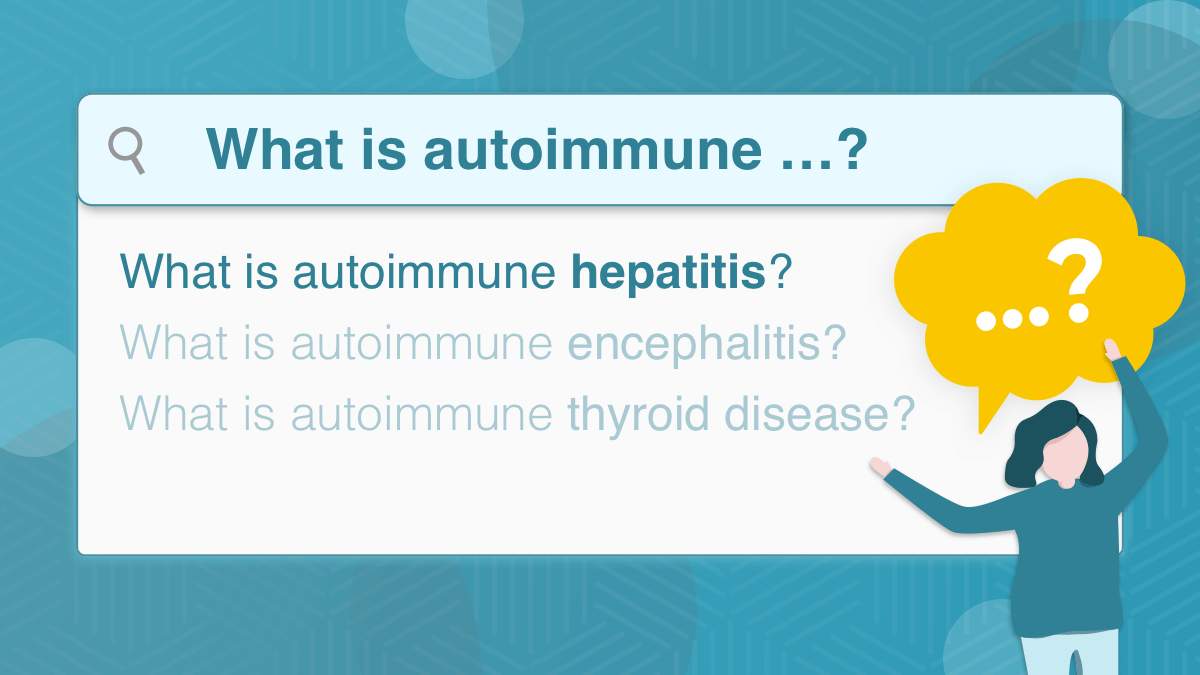Autoimmune diseases are complicated conditions. In this series, we take a look at three of the most commonly searched-for autoimmune diseases – autoimmune hepatitis, encephalitis, and thyroid disease – and explain the key points of each in simple, easy-to-understand language. In this article, we explain what autoimmune hepatitis is.
Other articles in this series:
- Autoimmune Diseases Explained: Autoimmune Encephalitis
- Autoimmune Diseases Explained: Autoimmune Thyroid Disease
What is an Autoimmune Disease?
The immune system is your body’s defense against from viruses and infections. When such invaders (pathogens) are detected, several immune responses kick into gear and aim to destroy them and keep your body healthy.
Antibodies are made to fight the pathogens.
In an individual living with an autoimmune disease, autoantibodies are produced and attack the body’s own tissue. The way in which it does so, and the specific tissue it targets, varies depending on which autoimmune disease one lives with.
In the case of rheumatoid arthritis, for example, the immune system attacks joints, leading to inflammation that results in swelling and pain.
Quite why the immune system attacks the body is not entirely understood. It seems genes play some role and individuals with a family history of autoimmune diseases may have a genetic disposition. In 2014, for example, researchers found a link between a mutation to a gene called ADAR1, which is involved in the body’s early response to foreign invaders, and autoimmune diseases such as lupus and motor neurone disease.
However, whether that disposition eventually results in developing a disease is not clear-cut.
It is widely believed that infections play a role in the actual development of a disease. Perhaps the best example of this is multiple sclerosis (MS), which causes the immune system to attack the fatty substance (myelin) surrounding the fibers of the central nerve system.
Viruses such as human herpesvirus 6 (HHV6) and Epstein-Barr virus (EBV) have been linked with MS. Most people are exposed to EBV during their lifetime but it usually symptomless. However, EBV can lead to another disease called mononucleosis (mono). Individuals who develop mono appear to be at an increased risk of MS.
However, while there does seem to be a connection between infections and autoimmune diseases, the cause and effect is not clear.
For now, most treatments for autoimmune diseases aims to control the immune responses and reduce inflammation, a common characteristic of autoimmune diseases.
What is Autoimmune Hepatitis?
The word hepatitis derives from the Greek word for liver, hēpar, combined the suffix -itis that is attached the name of diseases characterized by inflammation. While the various forms differ when it comes to aspects such as severity and symptoms, it is this inflammation of the liver that unites them under the umbrella of hepatitis.
Other posts you may be interested in on the MyTherapy blog:
- Christmas Disease: The Incredible Impact of Hemophilia B on European Royalty
- Type 1.5 Diabetes: Facts You Should Know About ‘The Other’ Form of Diabetes
The best-known forms – A, B, and C – are viral infections, as are hepatitis D and E. The virus can be spread in a multitude of ways, most infamously through unprotected sex and the sharing of needles for illicit drug use. Food and drink can also spread the infection, particularly when it comes to hepatitis A.
Viral forms of hepatitis can be acute (lasting less than six months) or chronic (lasting more than six months). Autoimmune hepatitis, as is invariably the case with autoimmune diseases, is a lifelong condition.
Although accurate prevalence figures are not readily available, autoimmune hepatitis is a rare disease. It is estimated that the prevalence in Northern Europe is 18 per 100,000 people, with 1.1 new cases per 100,000 each year. It is likely figures in US resemble this. Curiously, though, prevalence in the Native Alaskan population may be far higher, with studies estimating it to be as high as 58 per 100,000 people.
Exactly what causes autoimmune hepatitis is not fully understood. As previously mentioned, it is likely that some sort of genetic disposition exists, which leads to the development of the disease based on an environmental trigger. Several genes have been identified and linked with the disease, while Epstein-Barr virus, viral forms of hepatitis, and rubella, have been identified as possible triggers.
About 80% of people living with autoimmune diseases are women, a figure that holds true for autoimmune hepatitis.
It can occur at any age, although the less common “type 2” variant is more likely to occur in childhood. Some researchers consider there to be two types of autoimmune hepatitis – others three – which are differentiated by the autoantibody profile. Others consider such subdivisions to be unnecessary and of little practical benefit.
Unlike many autoimmune diseases, early immunosuppression treatment can lead to complete remission. In fact, it does so within a couple of years in 80% of cases. Once in remission people may choose to withdraw from medication, but in four out of five cases relapse occurs and treatment is once more required – usually lifelong.
If treatment is unsuccessful, or not administered at all, autoimmune hepatitis can lead to severe and irreversible scarring of the liver called cirrhosis. Eventually, it can lead to liver failure and end-stage liver disease, at which point a transplant may be required. Autoimmune hepatitis accounts for 6% of liver transplants in the US.
Overall, prognosis is generally good in those who respond to treatment. Even when a transplant is required, outcomes are often positive. So, while autoimmune hepatitis is undoubtedly a serious disease, it is one that can usually be well controlled and those living with it are often able to lead healthy lives.
Quick Facts About Autoimmune Hepatitis:
Autoimmune Hepatitis Symptoms
As is the case with viral hepatitis, autoimmune hepatitis can vary from being asymptomatic to presenting severe symptoms. Typically, they include:
- Fatigue
- Abdominal discomfort or pain
- Anorexia
- Skin rashes
- Itchy skin
- Joint pain
- Muscle pain
- Diarrhea
- Swelling
According to Medscape, a physical examination will like reveal:
- Hepatomegaly (enlargement of the liver) in 83% of cases
- Jaundice (yellowing of the skin) in 69% of cases
- Spider angioma (enlargement of blood vessels in the skin) in 58% of cases
- Splenomegaly (enlargement of the spleen) in 32% of cases
- Ascites (build-up of fluids in the abdomen) in 20% of cases
- Encephalopathy (some form of brain injury) in 14% of cases
Autoimmune Hepatitis Treatment
The first line of treatment is usually immunosuppressive therapy, often a combination of either prednisone and azathioprine or of budesonide and azathioprine. Alternatively, a higher dose of prednisone may be used without another drug, although this is not common.
Alternative drugs are mostly used in those with an intolerance to azathioprine.
In cases where autoimmune hepatitis is detected late, an individual may already have contracted cirrhosis or even liver failure, at which point a liver transplant is likely required.
Autoimmune Hepatitis Life Expectancy
According to Medscape, “the 10-year life expectancies for treated patients with and without cirrhosis at presentation are 89% and 90%, respectively. Indeed, the life expectancy of patients in clinical remission is similar to that of the general population.”
As we can see, the prognosis for those living with autoimmune hepatitis is generally good. However, a problem that is common among autoimmune diseases is the difficulty in making a diagnosis in the first place.
The symptoms are similar to those of viral hepatitis and other liver diseases, so it can take a combination of blood tests and a liver biopsy to conclusively diagnose autoimmune hepatitis.
Blood tests are used to detect levels of liver enzymes such as alanine transaminase (ALT) and aspartate transaminase (AST). With no other explanations, raised levels of these enzymes suggests autoimmune hepatitis may be responsible.
Blood tests can also detect the autoantibodies responsible for attacking the liver. The most common ones are called anti-smooth antibodies and anti-nuclear antibodies.
A biopsy can help confirm the diagnosis, rule out other causes, and determine the level of damage to the liver. During a biopsy, a small amount of tissue is removed for examination.
Combined, the above tests can lead to a conclusive diagnosis.
Related Autoimmune Diseases
While an accurate diagnosis will often lead to effective treatment, 30% of people living with autoimmune hepatitis also have at least one other autoimmune disease such as autoimmune thyroid disease.
That figure is not surprising, as about one in four people living with an autoimmune disease develop additional conditions.
It is still unclear exactly why the immune system attacks healthy cells, and autoimmune diseases remain are shrouded in mystery. One of the biggest challenges is detecting such diseases early, which can significantly reduce the damage they cause and the risk of subsequent complications.
The good news regarding autoimmune hepatitis is that treatment is often effective in achieving remission and can help people live a long and healthy life.
Take a look at some of the other posts on the MyTherapy blog:



